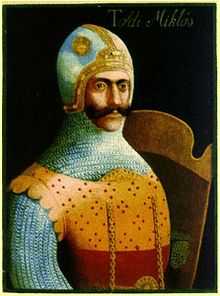Miklós Toldi
| Miklós Toldi | |
|---|---|
 | |
| Born | c. 1320 |
| Died | November 22, 1390 |
Miklós Toldi (c. 1320 – November 22, 1390) was a Hungarian nobleman from Bihar County of the Kingdom of Hungary, who is remembered as a legendary strong hero in Hungarian folklore. Hungarian poet János Arany based his famous Toldi trilogy on his legend.
Life
Toldi was long regarded as a fictional person as few data survived to the present about his life. It has been shown from charters that Miklós Toldi and György Toldi were real persons in the age of kings Charles Robert and Louis the Great.[1] He is mentioned in 1354 as the alispán and várnagy of Pozsony County, in 1383 and 1385 as the főispán (English: count) of Szabolcs County. He took part in the campaigns of Louis the Great in Italy as a mercenary leader. In 1359, on request of the king, he brought two lion cubs from Firenze. He had to flee his home because he killed a soldier of his brother, György.
Legacy
The earliest and most detailed source about him is Péter Ilosvai Selymes's Az híres nevezetes Toldi Miklósnak jeles cselekedeteiről és bajnokosodásáról való história (Story of the great deeds and braveries of the fabulous Miklós Toldi, Debrecen, 1574).
In folklore, Toldi has been remembered the longest in Nógrád and Bihar County and they emphasize his physical strength but place him to the age of King Matthias Corvinus, that is, a century later.
The most famous work about Miklós Toldi is the Toldi trilogy by János Arany. A motive for him to write about Toldi was that, according to the tradition, the Stumpy Tower (Csonka-torony) near his town of birth Nagyszalonta, had been owned by the Toldi family. Arany's trilogy was adapted into an animated film in the 1980s under the title Heroic Times.
The Toldi, a Hungarian light tank developed and used during World War II, was named after him.
References
- ↑ Bertalan Korompay: Adalékok és jegyzetek a Toldi-mondához (Datas and notes for Toldi's legend)(Irod. tört. Közl., 1956)
